Nursing 1 Report: Impact of Stress-Related Medical Errors by RNs
VerifiedAdded on 2022/10/14
|20
|5913
|9
Report
AI Summary
This report examines the significant impact of stress on medical errors committed by registered nurses, a critical issue affecting patient safety and healthcare quality. The introduction highlights the prevalence of medical errors globally, emphasizing the role of stress as a leading cause, and the need for safe healthcare practices. The literature search process is detailed, including the search strategy, inclusion and exclusion criteria, and the databases used to gather relevant research. The literature review explores the nature and definition of stress, identifying various sources of stress in the nursing profession, such as heavy workloads, interpersonal relationships, and organizational factors. It further examines the relationship between stress and medical errors, including the impact of stress on cognitive function, concentration, and medication errors. The report synthesizes findings from multiple studies to provide a comprehensive overview of the issue, emphasizing the need for interventions to mitigate stress and improve patient outcomes.
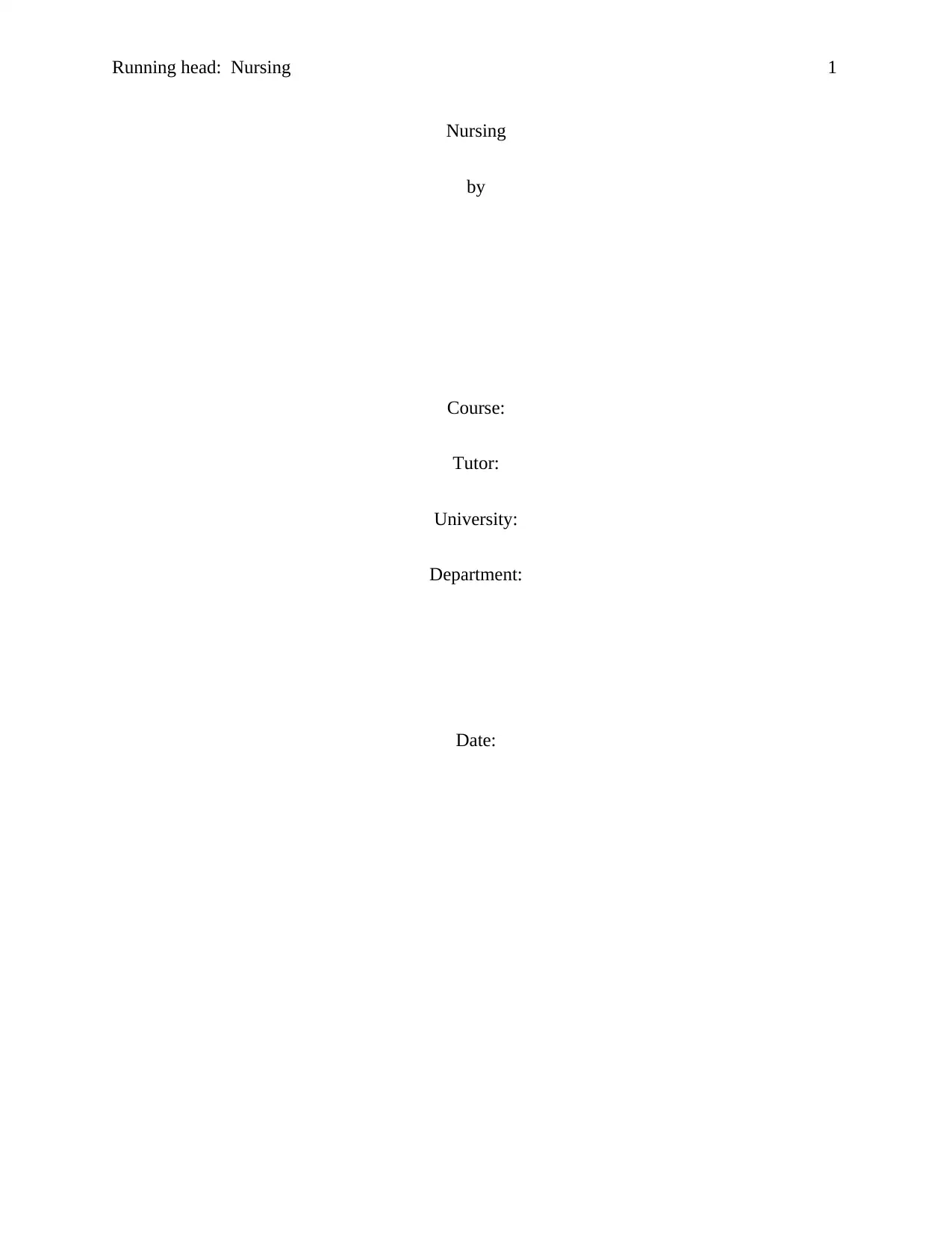
Running head: Nursing 1
Nursing
by
Course:
Tutor:
University:
Department:
Date:
Nursing
by
Course:
Tutor:
University:
Department:
Date:
Paraphrase This Document
Need a fresh take? Get an instant paraphrase of this document with our AI Paraphraser
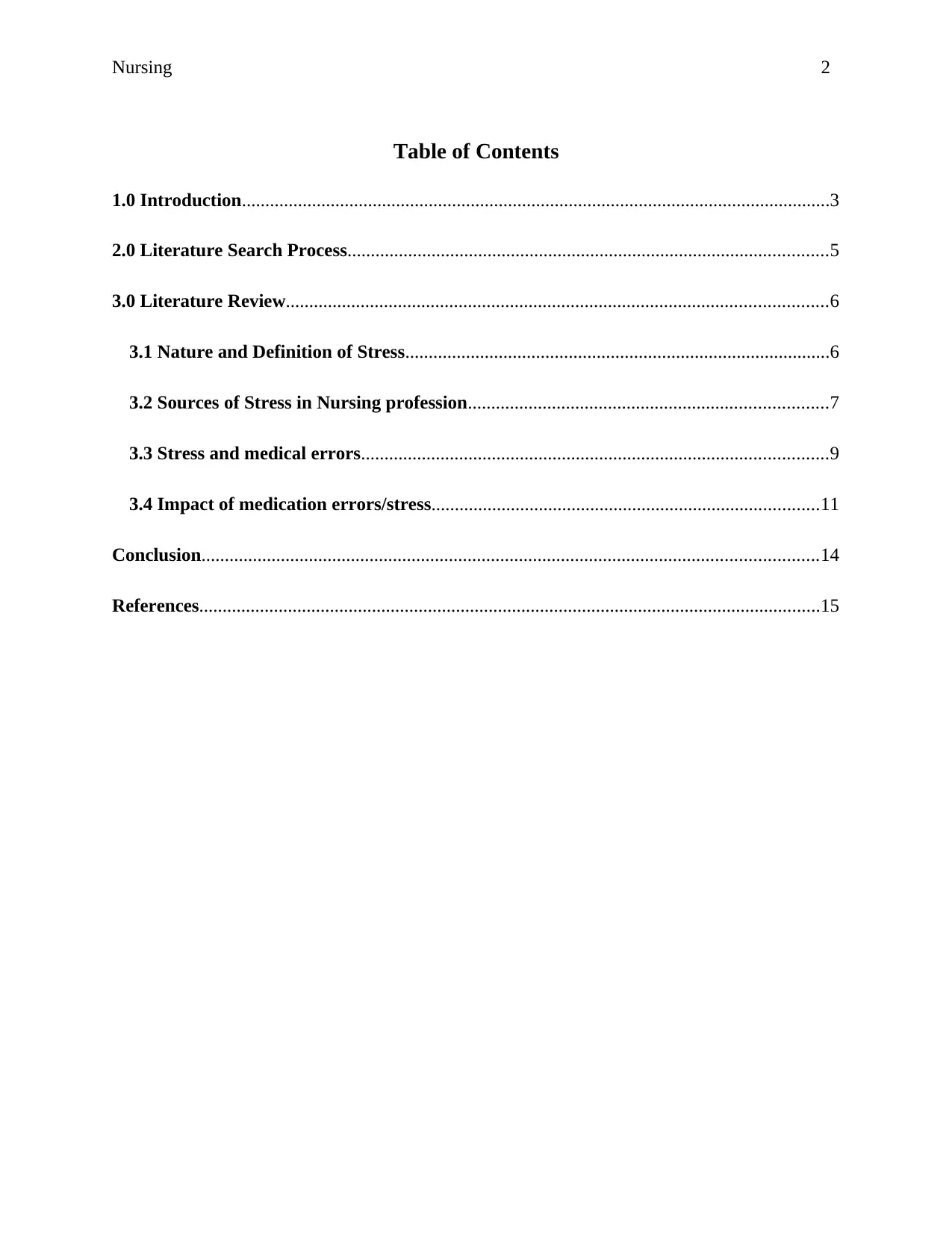
Nursing 2
Table of Contents
1.0 Introduction..............................................................................................................................3
2.0 Literature Search Process.......................................................................................................5
3.0 Literature Review....................................................................................................................6
3.1 Nature and Definition of Stress...........................................................................................6
3.2 Sources of Stress in Nursing profession.............................................................................7
3.3 Stress and medical errors....................................................................................................9
3.4 Impact of medication errors/stress...................................................................................11
Conclusion....................................................................................................................................14
References.....................................................................................................................................15
Table of Contents
1.0 Introduction..............................................................................................................................3
2.0 Literature Search Process.......................................................................................................5
3.0 Literature Review....................................................................................................................6
3.1 Nature and Definition of Stress...........................................................................................6
3.2 Sources of Stress in Nursing profession.............................................................................7
3.3 Stress and medical errors....................................................................................................9
3.4 Impact of medication errors/stress...................................................................................11
Conclusion....................................................................................................................................14
References.....................................................................................................................................15
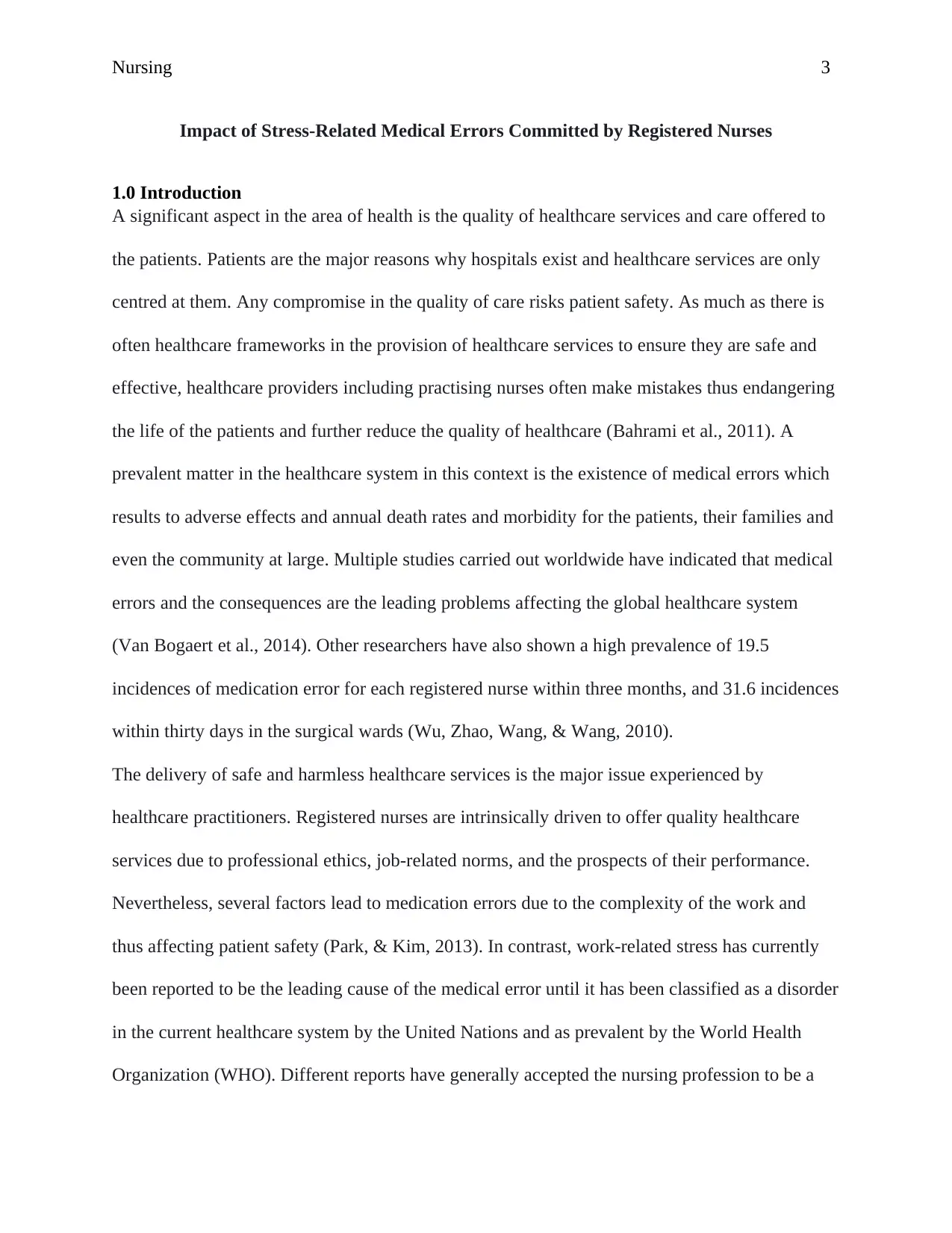
Nursing 3
Impact of Stress-Related Medical Errors Committed by Registered Nurses
1.0 Introduction
A significant aspect in the area of health is the quality of healthcare services and care offered to
the patients. Patients are the major reasons why hospitals exist and healthcare services are only
centred at them. Any compromise in the quality of care risks patient safety. As much as there is
often healthcare frameworks in the provision of healthcare services to ensure they are safe and
effective, healthcare providers including practising nurses often make mistakes thus endangering
the life of the patients and further reduce the quality of healthcare (Bahrami et al., 2011). A
prevalent matter in the healthcare system in this context is the existence of medical errors which
results to adverse effects and annual death rates and morbidity for the patients, their families and
even the community at large. Multiple studies carried out worldwide have indicated that medical
errors and the consequences are the leading problems affecting the global healthcare system
(Van Bogaert et al., 2014). Other researchers have also shown a high prevalence of 19.5
incidences of medication error for each registered nurse within three months, and 31.6 incidences
within thirty days in the surgical wards (Wu, Zhao, Wang, & Wang, 2010).
The delivery of safe and harmless healthcare services is the major issue experienced by
healthcare practitioners. Registered nurses are intrinsically driven to offer quality healthcare
services due to professional ethics, job-related norms, and the prospects of their performance.
Nevertheless, several factors lead to medication errors due to the complexity of the work and
thus affecting patient safety (Park, & Kim, 2013). In contrast, work-related stress has currently
been reported to be the leading cause of the medical error until it has been classified as a disorder
in the current healthcare system by the United Nations and as prevalent by the World Health
Organization (WHO). Different reports have generally accepted the nursing profession to be a
Impact of Stress-Related Medical Errors Committed by Registered Nurses
1.0 Introduction
A significant aspect in the area of health is the quality of healthcare services and care offered to
the patients. Patients are the major reasons why hospitals exist and healthcare services are only
centred at them. Any compromise in the quality of care risks patient safety. As much as there is
often healthcare frameworks in the provision of healthcare services to ensure they are safe and
effective, healthcare providers including practising nurses often make mistakes thus endangering
the life of the patients and further reduce the quality of healthcare (Bahrami et al., 2011). A
prevalent matter in the healthcare system in this context is the existence of medical errors which
results to adverse effects and annual death rates and morbidity for the patients, their families and
even the community at large. Multiple studies carried out worldwide have indicated that medical
errors and the consequences are the leading problems affecting the global healthcare system
(Van Bogaert et al., 2014). Other researchers have also shown a high prevalence of 19.5
incidences of medication error for each registered nurse within three months, and 31.6 incidences
within thirty days in the surgical wards (Wu, Zhao, Wang, & Wang, 2010).
The delivery of safe and harmless healthcare services is the major issue experienced by
healthcare practitioners. Registered nurses are intrinsically driven to offer quality healthcare
services due to professional ethics, job-related norms, and the prospects of their performance.
Nevertheless, several factors lead to medication errors due to the complexity of the work and
thus affecting patient safety (Park, & Kim, 2013). In contrast, work-related stress has currently
been reported to be the leading cause of the medical error until it has been classified as a disorder
in the current healthcare system by the United Nations and as prevalent by the World Health
Organization (WHO). Different reports have generally accepted the nursing profession to be a
⊘ This is a preview!⊘
Do you want full access?
Subscribe today to unlock all pages.

Trusted by 1+ million students worldwide
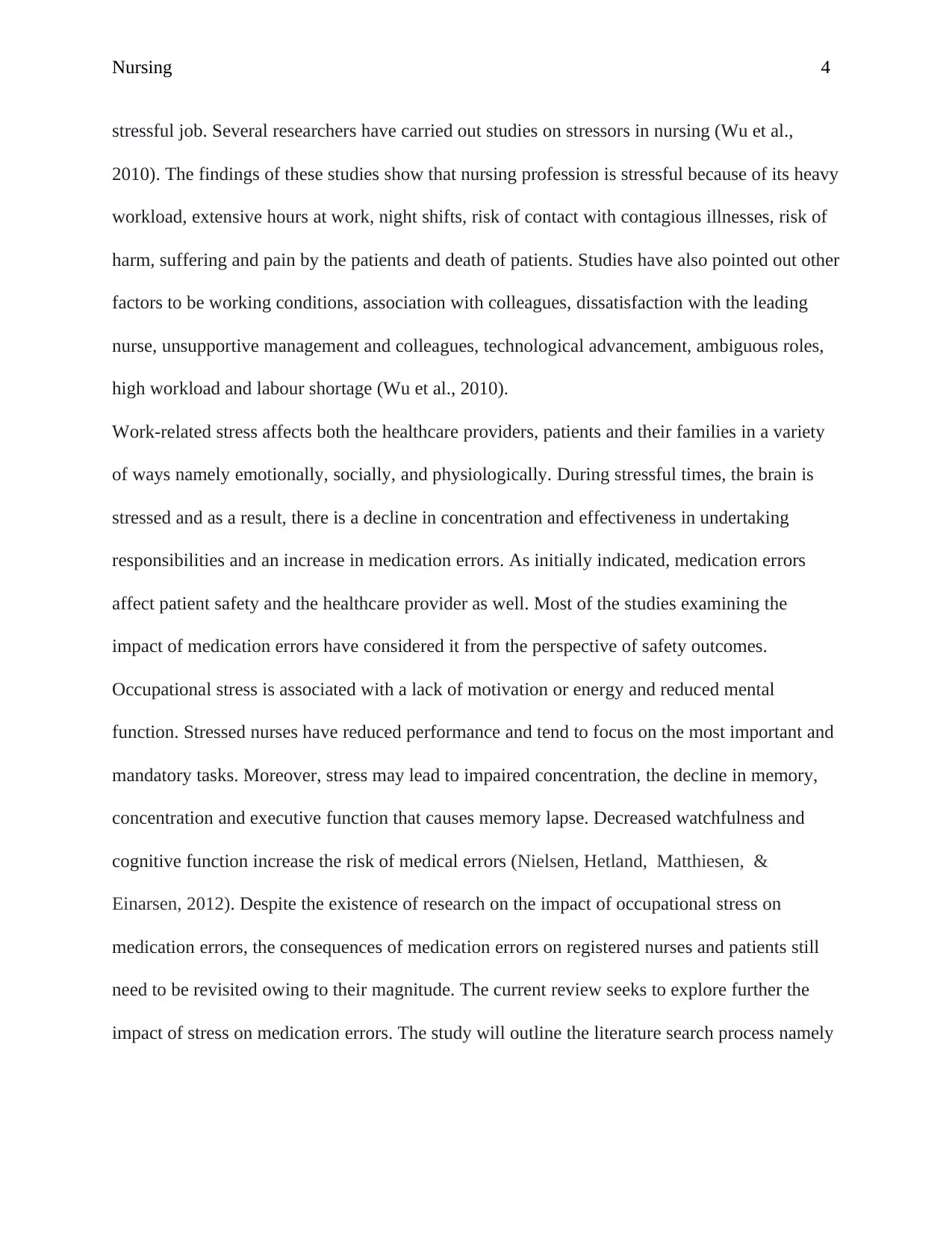
Nursing 4
stressful job. Several researchers have carried out studies on stressors in nursing (Wu et al.,
2010). The findings of these studies show that nursing profession is stressful because of its heavy
workload, extensive hours at work, night shifts, risk of contact with contagious illnesses, risk of
harm, suffering and pain by the patients and death of patients. Studies have also pointed out other
factors to be working conditions, association with colleagues, dissatisfaction with the leading
nurse, unsupportive management and colleagues, technological advancement, ambiguous roles,
high workload and labour shortage (Wu et al., 2010).
Work-related stress affects both the healthcare providers, patients and their families in a variety
of ways namely emotionally, socially, and physiologically. During stressful times, the brain is
stressed and as a result, there is a decline in concentration and effectiveness in undertaking
responsibilities and an increase in medication errors. As initially indicated, medication errors
affect patient safety and the healthcare provider as well. Most of the studies examining the
impact of medication errors have considered it from the perspective of safety outcomes.
Occupational stress is associated with a lack of motivation or energy and reduced mental
function. Stressed nurses have reduced performance and tend to focus on the most important and
mandatory tasks. Moreover, stress may lead to impaired concentration, the decline in memory,
concentration and executive function that causes memory lapse. Decreased watchfulness and
cognitive function increase the risk of medical errors (Nielsen, Hetland, Matthiesen, &
Einarsen, 2012). Despite the existence of research on the impact of occupational stress on
medication errors, the consequences of medication errors on registered nurses and patients still
need to be revisited owing to their magnitude. The current review seeks to explore further the
impact of stress on medication errors. The study will outline the literature search process namely
stressful job. Several researchers have carried out studies on stressors in nursing (Wu et al.,
2010). The findings of these studies show that nursing profession is stressful because of its heavy
workload, extensive hours at work, night shifts, risk of contact with contagious illnesses, risk of
harm, suffering and pain by the patients and death of patients. Studies have also pointed out other
factors to be working conditions, association with colleagues, dissatisfaction with the leading
nurse, unsupportive management and colleagues, technological advancement, ambiguous roles,
high workload and labour shortage (Wu et al., 2010).
Work-related stress affects both the healthcare providers, patients and their families in a variety
of ways namely emotionally, socially, and physiologically. During stressful times, the brain is
stressed and as a result, there is a decline in concentration and effectiveness in undertaking
responsibilities and an increase in medication errors. As initially indicated, medication errors
affect patient safety and the healthcare provider as well. Most of the studies examining the
impact of medication errors have considered it from the perspective of safety outcomes.
Occupational stress is associated with a lack of motivation or energy and reduced mental
function. Stressed nurses have reduced performance and tend to focus on the most important and
mandatory tasks. Moreover, stress may lead to impaired concentration, the decline in memory,
concentration and executive function that causes memory lapse. Decreased watchfulness and
cognitive function increase the risk of medical errors (Nielsen, Hetland, Matthiesen, &
Einarsen, 2012). Despite the existence of research on the impact of occupational stress on
medication errors, the consequences of medication errors on registered nurses and patients still
need to be revisited owing to their magnitude. The current review seeks to explore further the
impact of stress on medication errors. The study will outline the literature search process namely
Paraphrase This Document
Need a fresh take? Get an instant paraphrase of this document with our AI Paraphraser
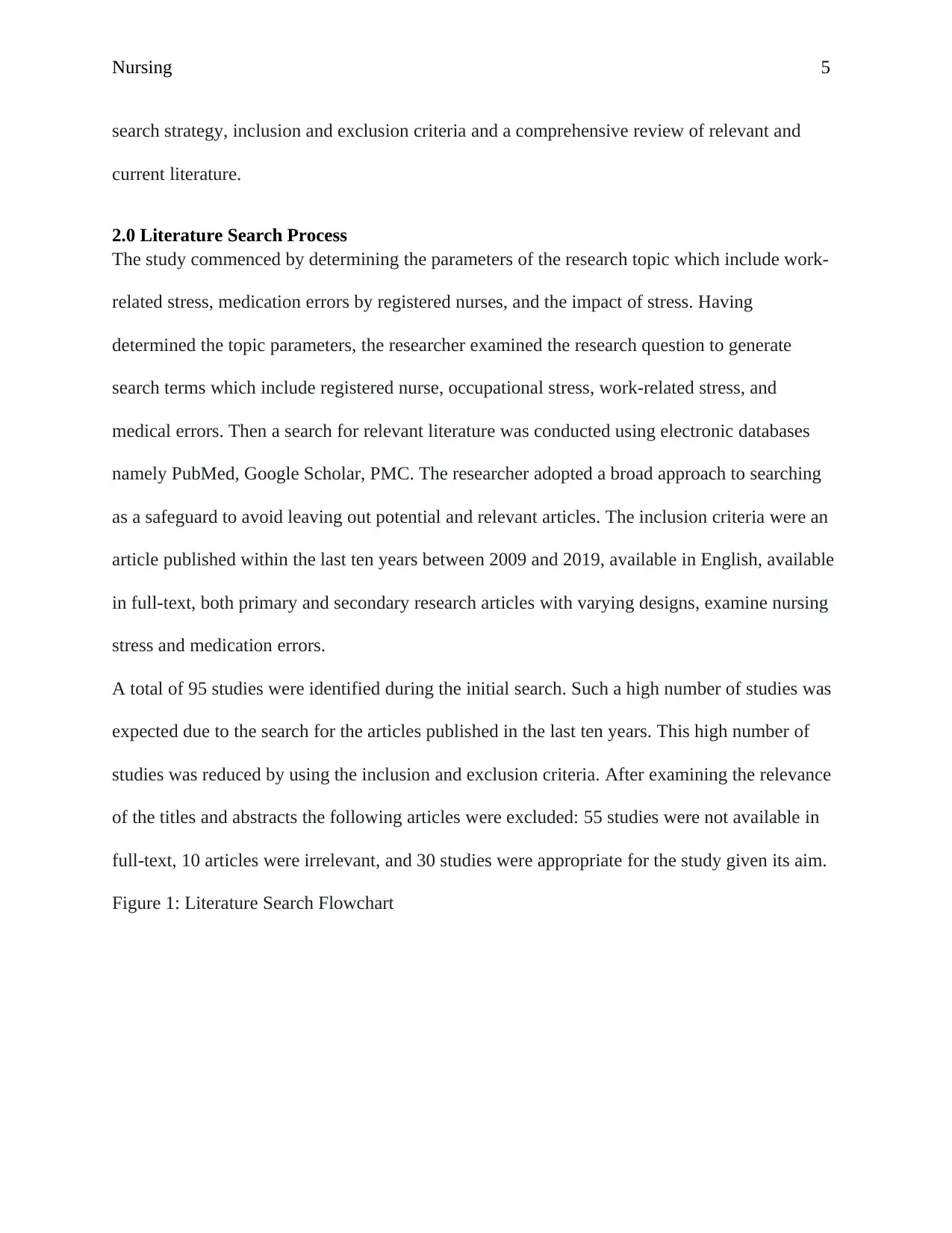
Nursing 5
search strategy, inclusion and exclusion criteria and a comprehensive review of relevant and
current literature.
2.0 Literature Search Process
The study commenced by determining the parameters of the research topic which include work-
related stress, medication errors by registered nurses, and the impact of stress. Having
determined the topic parameters, the researcher examined the research question to generate
search terms which include registered nurse, occupational stress, work-related stress, and
medical errors. Then a search for relevant literature was conducted using electronic databases
namely PubMed, Google Scholar, PMC. The researcher adopted a broad approach to searching
as a safeguard to avoid leaving out potential and relevant articles. The inclusion criteria were an
article published within the last ten years between 2009 and 2019, available in English, available
in full-text, both primary and secondary research articles with varying designs, examine nursing
stress and medication errors.
A total of 95 studies were identified during the initial search. Such a high number of studies was
expected due to the search for the articles published in the last ten years. This high number of
studies was reduced by using the inclusion and exclusion criteria. After examining the relevance
of the titles and abstracts the following articles were excluded: 55 studies were not available in
full-text, 10 articles were irrelevant, and 30 studies were appropriate for the study given its aim.
Figure 1: Literature Search Flowchart
search strategy, inclusion and exclusion criteria and a comprehensive review of relevant and
current literature.
2.0 Literature Search Process
The study commenced by determining the parameters of the research topic which include work-
related stress, medication errors by registered nurses, and the impact of stress. Having
determined the topic parameters, the researcher examined the research question to generate
search terms which include registered nurse, occupational stress, work-related stress, and
medical errors. Then a search for relevant literature was conducted using electronic databases
namely PubMed, Google Scholar, PMC. The researcher adopted a broad approach to searching
as a safeguard to avoid leaving out potential and relevant articles. The inclusion criteria were an
article published within the last ten years between 2009 and 2019, available in English, available
in full-text, both primary and secondary research articles with varying designs, examine nursing
stress and medication errors.
A total of 95 studies were identified during the initial search. Such a high number of studies was
expected due to the search for the articles published in the last ten years. This high number of
studies was reduced by using the inclusion and exclusion criteria. After examining the relevance
of the titles and abstracts the following articles were excluded: 55 studies were not available in
full-text, 10 articles were irrelevant, and 30 studies were appropriate for the study given its aim.
Figure 1: Literature Search Flowchart
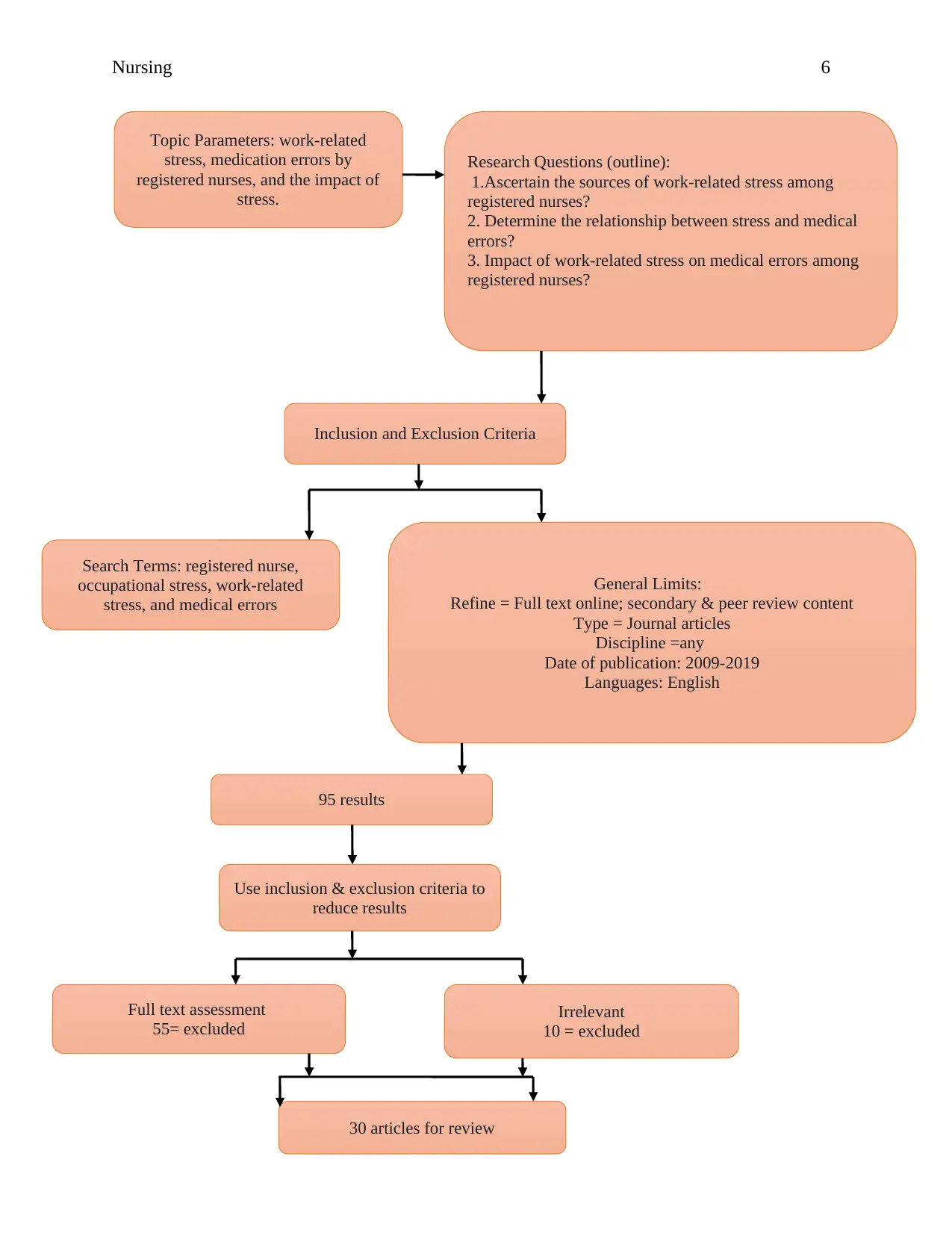
Nursing 6
Topic Parameters: work-related
stress, medication errors by
registered nurses, and the impact of
stress.
Research Questions (outline):
1.Ascertain the sources of work-related stress among
registered nurses?
2. Determine the relationship between stress and medical
errors?
3. Impact of work-related stress on medical errors among
registered nurses?
Inclusion and Exclusion Criteria
Search Terms: registered nurse,
occupational stress, work-related
stress, and medical errors
General Limits:
Refine = Full text online; secondary & peer review content
Type = Journal articles
Discipline =any
Date of publication: 2009-2019
Languages: English
95 results
Use inclusion & exclusion criteria to
reduce results
Full text assessment
55= excluded
Irrelevant
10 = excluded
30 articles for review
Topic Parameters: work-related
stress, medication errors by
registered nurses, and the impact of
stress.
Research Questions (outline):
1.Ascertain the sources of work-related stress among
registered nurses?
2. Determine the relationship between stress and medical
errors?
3. Impact of work-related stress on medical errors among
registered nurses?
Inclusion and Exclusion Criteria
Search Terms: registered nurse,
occupational stress, work-related
stress, and medical errors
General Limits:
Refine = Full text online; secondary & peer review content
Type = Journal articles
Discipline =any
Date of publication: 2009-2019
Languages: English
95 results
Use inclusion & exclusion criteria to
reduce results
Full text assessment
55= excluded
Irrelevant
10 = excluded
30 articles for review
⊘ This is a preview!⊘
Do you want full access?
Subscribe today to unlock all pages.

Trusted by 1+ million students worldwide
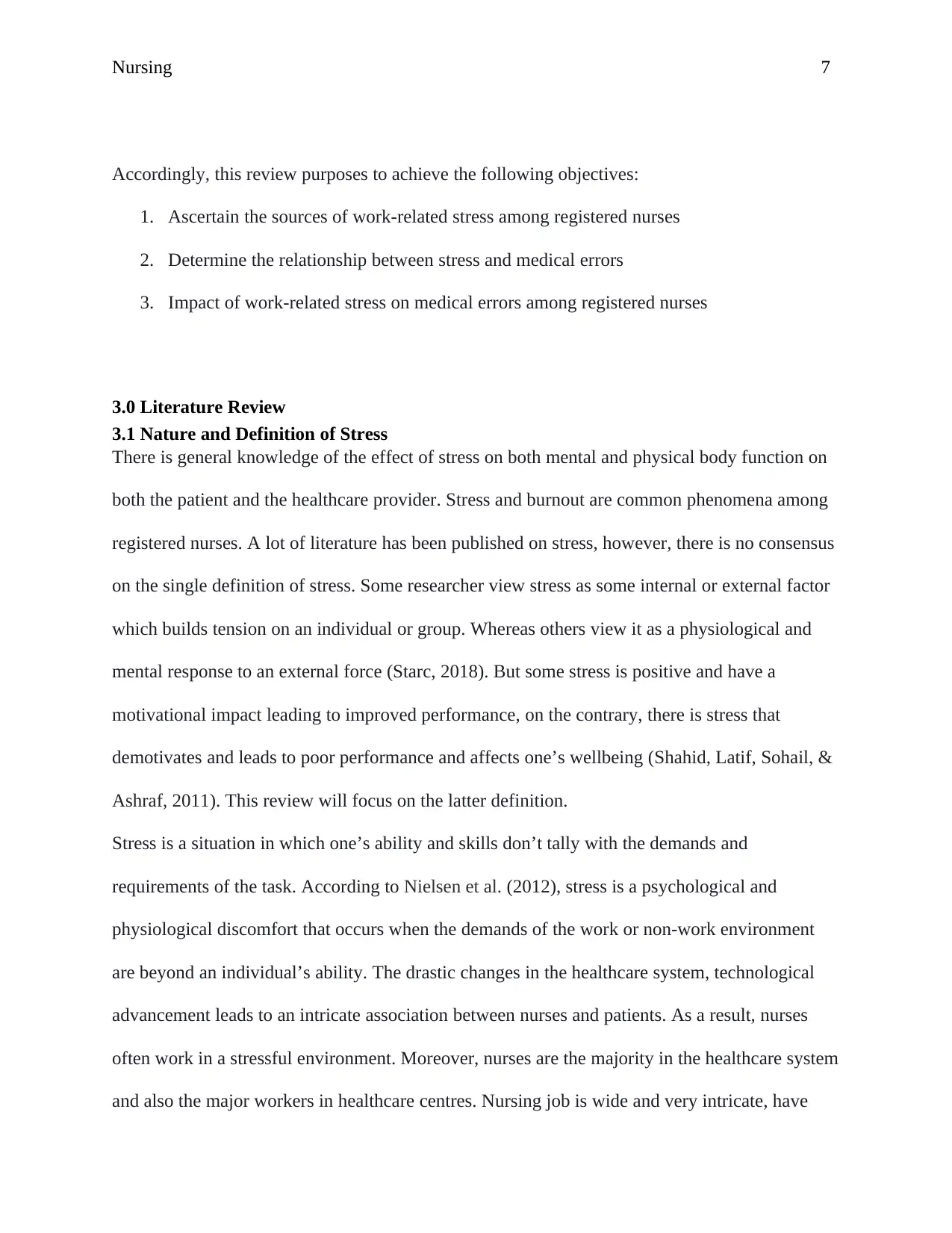
Nursing 7
Accordingly, this review purposes to achieve the following objectives:
1. Ascertain the sources of work-related stress among registered nurses
2. Determine the relationship between stress and medical errors
3. Impact of work-related stress on medical errors among registered nurses
3.0 Literature Review
3.1 Nature and Definition of Stress
There is general knowledge of the effect of stress on both mental and physical body function on
both the patient and the healthcare provider. Stress and burnout are common phenomena among
registered nurses. A lot of literature has been published on stress, however, there is no consensus
on the single definition of stress. Some researcher view stress as some internal or external factor
which builds tension on an individual or group. Whereas others view it as a physiological and
mental response to an external force (Starc, 2018). But some stress is positive and have a
motivational impact leading to improved performance, on the contrary, there is stress that
demotivates and leads to poor performance and affects one’s wellbeing (Shahid, Latif, Sohail, &
Ashraf, 2011). This review will focus on the latter definition.
Stress is a situation in which one’s ability and skills don’t tally with the demands and
requirements of the task. According to Nielsen et al. (2012), stress is a psychological and
physiological discomfort that occurs when the demands of the work or non-work environment
are beyond an individual’s ability. The drastic changes in the healthcare system, technological
advancement leads to an intricate association between nurses and patients. As a result, nurses
often work in a stressful environment. Moreover, nurses are the majority in the healthcare system
and also the major workers in healthcare centres. Nursing job is wide and very intricate, have
Accordingly, this review purposes to achieve the following objectives:
1. Ascertain the sources of work-related stress among registered nurses
2. Determine the relationship between stress and medical errors
3. Impact of work-related stress on medical errors among registered nurses
3.0 Literature Review
3.1 Nature and Definition of Stress
There is general knowledge of the effect of stress on both mental and physical body function on
both the patient and the healthcare provider. Stress and burnout are common phenomena among
registered nurses. A lot of literature has been published on stress, however, there is no consensus
on the single definition of stress. Some researcher view stress as some internal or external factor
which builds tension on an individual or group. Whereas others view it as a physiological and
mental response to an external force (Starc, 2018). But some stress is positive and have a
motivational impact leading to improved performance, on the contrary, there is stress that
demotivates and leads to poor performance and affects one’s wellbeing (Shahid, Latif, Sohail, &
Ashraf, 2011). This review will focus on the latter definition.
Stress is a situation in which one’s ability and skills don’t tally with the demands and
requirements of the task. According to Nielsen et al. (2012), stress is a psychological and
physiological discomfort that occurs when the demands of the work or non-work environment
are beyond an individual’s ability. The drastic changes in the healthcare system, technological
advancement leads to an intricate association between nurses and patients. As a result, nurses
often work in a stressful environment. Moreover, nurses are the majority in the healthcare system
and also the major workers in healthcare centres. Nursing job is wide and very intricate, have
Paraphrase This Document
Need a fresh take? Get an instant paraphrase of this document with our AI Paraphraser
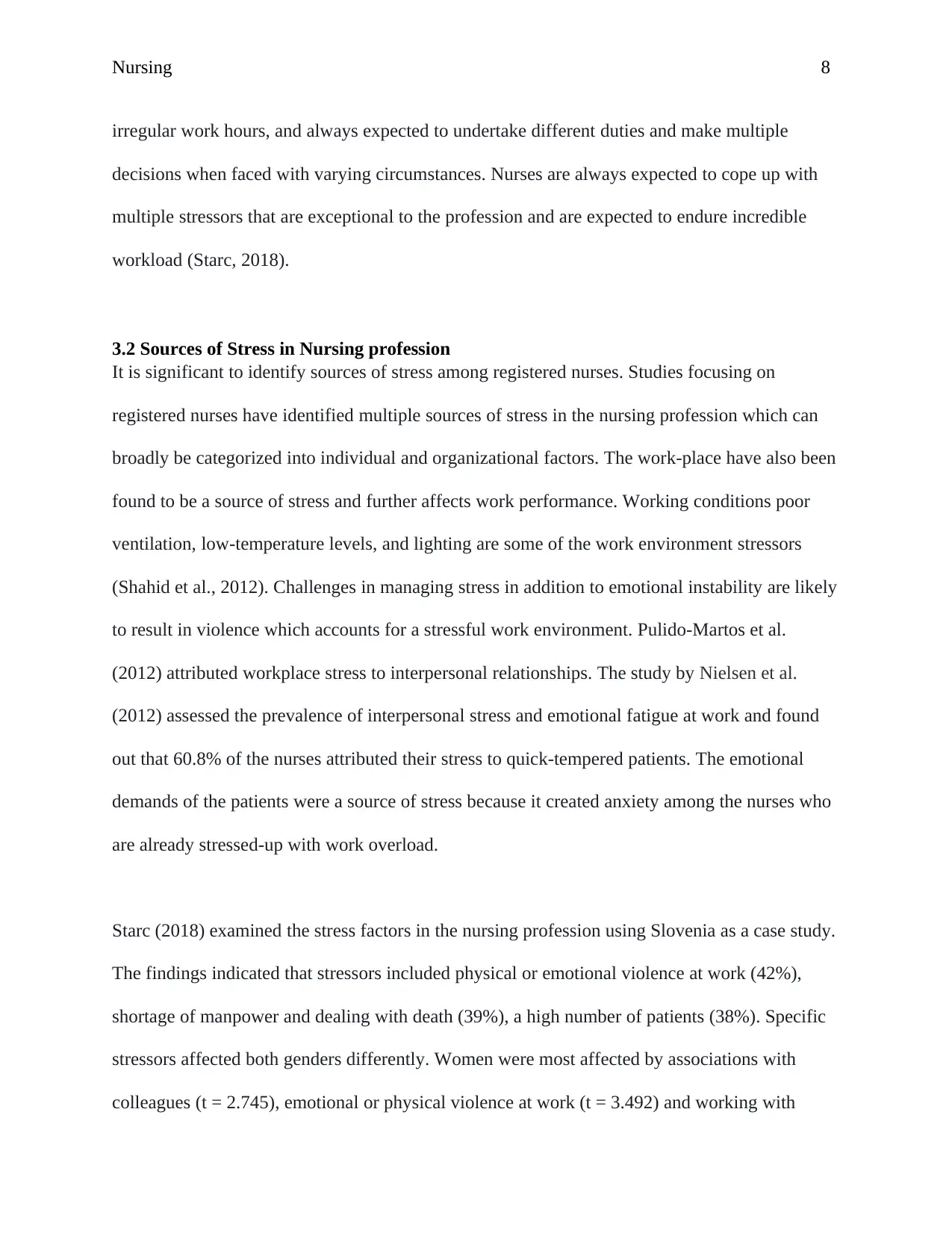
Nursing 8
irregular work hours, and always expected to undertake different duties and make multiple
decisions when faced with varying circumstances. Nurses are always expected to cope up with
multiple stressors that are exceptional to the profession and are expected to endure incredible
workload (Starc, 2018).
3.2 Sources of Stress in Nursing profession
It is significant to identify sources of stress among registered nurses. Studies focusing on
registered nurses have identified multiple sources of stress in the nursing profession which can
broadly be categorized into individual and organizational factors. The work-place have also been
found to be a source of stress and further affects work performance. Working conditions poor
ventilation, low-temperature levels, and lighting are some of the work environment stressors
(Shahid et al., 2012). Challenges in managing stress in addition to emotional instability are likely
to result in violence which accounts for a stressful work environment. Pulido‐Martos et al.
(2012) attributed workplace stress to interpersonal relationships. The study by Nielsen et al.
(2012) assessed the prevalence of interpersonal stress and emotional fatigue at work and found
out that 60.8% of the nurses attributed their stress to quick-tempered patients. The emotional
demands of the patients were a source of stress because it created anxiety among the nurses who
are already stressed-up with work overload.
Starc (2018) examined the stress factors in the nursing profession using Slovenia as a case study.
The findings indicated that stressors included physical or emotional violence at work (42%),
shortage of manpower and dealing with death (39%), a high number of patients (38%). Specific
stressors affected both genders differently. Women were most affected by associations with
colleagues (t = 2.745), emotional or physical violence at work (t = 3.492) and working with
irregular work hours, and always expected to undertake different duties and make multiple
decisions when faced with varying circumstances. Nurses are always expected to cope up with
multiple stressors that are exceptional to the profession and are expected to endure incredible
workload (Starc, 2018).
3.2 Sources of Stress in Nursing profession
It is significant to identify sources of stress among registered nurses. Studies focusing on
registered nurses have identified multiple sources of stress in the nursing profession which can
broadly be categorized into individual and organizational factors. The work-place have also been
found to be a source of stress and further affects work performance. Working conditions poor
ventilation, low-temperature levels, and lighting are some of the work environment stressors
(Shahid et al., 2012). Challenges in managing stress in addition to emotional instability are likely
to result in violence which accounts for a stressful work environment. Pulido‐Martos et al.
(2012) attributed workplace stress to interpersonal relationships. The study by Nielsen et al.
(2012) assessed the prevalence of interpersonal stress and emotional fatigue at work and found
out that 60.8% of the nurses attributed their stress to quick-tempered patients. The emotional
demands of the patients were a source of stress because it created anxiety among the nurses who
are already stressed-up with work overload.
Starc (2018) examined the stress factors in the nursing profession using Slovenia as a case study.
The findings indicated that stressors included physical or emotional violence at work (42%),
shortage of manpower and dealing with death (39%), a high number of patients (38%). Specific
stressors affected both genders differently. Women were most affected by associations with
colleagues (t = 2.745), emotional or physical violence at work (t = 3.492) and working with
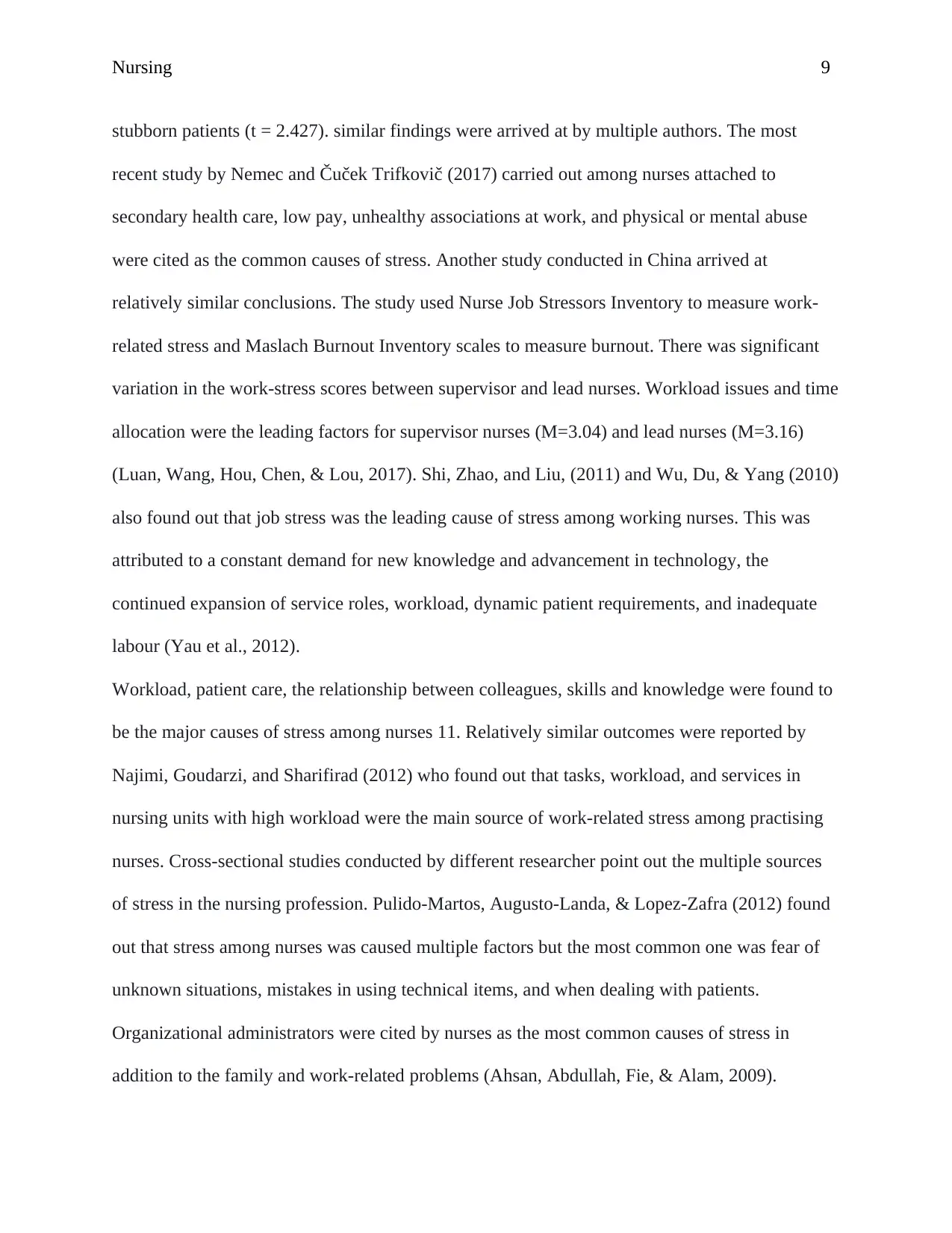
Nursing 9
stubborn patients (t = 2.427). similar findings were arrived at by multiple authors. The most
recent study by Nemec and Čuček Trifkovič (2017) carried out among nurses attached to
secondary health care, low pay, unhealthy associations at work, and physical or mental abuse
were cited as the common causes of stress. Another study conducted in China arrived at
relatively similar conclusions. The study used Nurse Job Stressors Inventory to measure work-
related stress and Maslach Burnout Inventory scales to measure burnout. There was significant
variation in the work-stress scores between supervisor and lead nurses. Workload issues and time
allocation were the leading factors for supervisor nurses (M=3.04) and lead nurses (M=3.16)
(Luan, Wang, Hou, Chen, & Lou, 2017). Shi, Zhao, and Liu, (2011) and Wu, Du, & Yang (2010)
also found out that job stress was the leading cause of stress among working nurses. This was
attributed to a constant demand for new knowledge and advancement in technology, the
continued expansion of service roles, workload, dynamic patient requirements, and inadequate
labour (Yau et al., 2012).
Workload, patient care, the relationship between colleagues, skills and knowledge were found to
be the major causes of stress among nurses 11. Relatively similar outcomes were reported by
Najimi, Goudarzi, and Sharifirad (2012) who found out that tasks, workload, and services in
nursing units with high workload were the main source of work-related stress among practising
nurses. Cross-sectional studies conducted by different researcher point out the multiple sources
of stress in the nursing profession. Pulido‐Martos, Augusto‐Landa, & Lopez‐Zafra (2012) found
out that stress among nurses was caused multiple factors but the most common one was fear of
unknown situations, mistakes in using technical items, and when dealing with patients.
Organizational administrators were cited by nurses as the most common causes of stress in
addition to the family and work-related problems (Ahsan, Abdullah, Fie, & Alam, 2009).
stubborn patients (t = 2.427). similar findings were arrived at by multiple authors. The most
recent study by Nemec and Čuček Trifkovič (2017) carried out among nurses attached to
secondary health care, low pay, unhealthy associations at work, and physical or mental abuse
were cited as the common causes of stress. Another study conducted in China arrived at
relatively similar conclusions. The study used Nurse Job Stressors Inventory to measure work-
related stress and Maslach Burnout Inventory scales to measure burnout. There was significant
variation in the work-stress scores between supervisor and lead nurses. Workload issues and time
allocation were the leading factors for supervisor nurses (M=3.04) and lead nurses (M=3.16)
(Luan, Wang, Hou, Chen, & Lou, 2017). Shi, Zhao, and Liu, (2011) and Wu, Du, & Yang (2010)
also found out that job stress was the leading cause of stress among working nurses. This was
attributed to a constant demand for new knowledge and advancement in technology, the
continued expansion of service roles, workload, dynamic patient requirements, and inadequate
labour (Yau et al., 2012).
Workload, patient care, the relationship between colleagues, skills and knowledge were found to
be the major causes of stress among nurses 11. Relatively similar outcomes were reported by
Najimi, Goudarzi, and Sharifirad (2012) who found out that tasks, workload, and services in
nursing units with high workload were the main source of work-related stress among practising
nurses. Cross-sectional studies conducted by different researcher point out the multiple sources
of stress in the nursing profession. Pulido‐Martos, Augusto‐Landa, & Lopez‐Zafra (2012) found
out that stress among nurses was caused multiple factors but the most common one was fear of
unknown situations, mistakes in using technical items, and when dealing with patients.
Organizational administrators were cited by nurses as the most common causes of stress in
addition to the family and work-related problems (Ahsan, Abdullah, Fie, & Alam, 2009).
⊘ This is a preview!⊘
Do you want full access?
Subscribe today to unlock all pages.

Trusted by 1+ million students worldwide
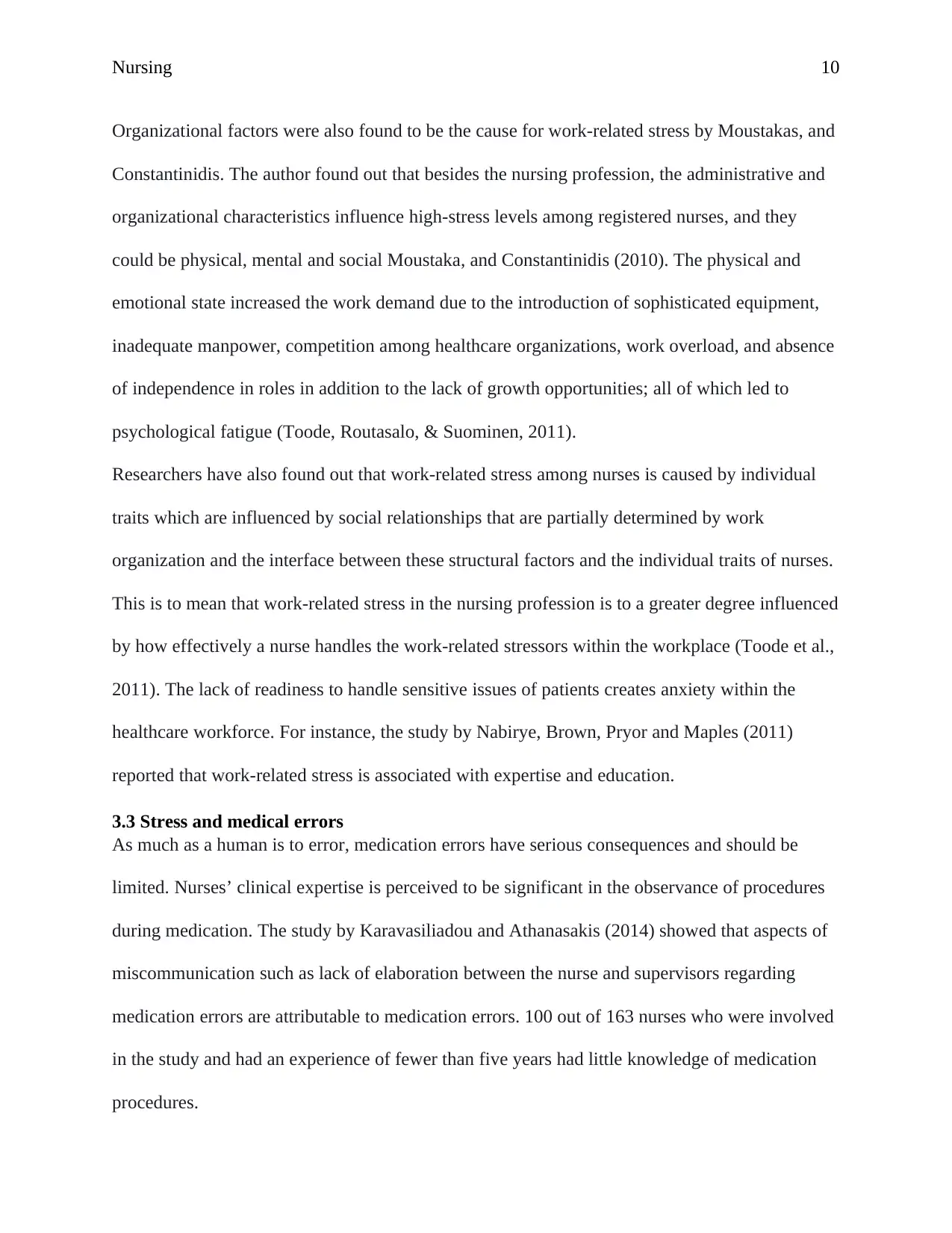
Nursing 10
Organizational factors were also found to be the cause for work-related stress by Moustakas, and
Constantinidis. The author found out that besides the nursing profession, the administrative and
organizational characteristics influence high-stress levels among registered nurses, and they
could be physical, mental and social Moustaka, and Constantinidis (2010). The physical and
emotional state increased the work demand due to the introduction of sophisticated equipment,
inadequate manpower, competition among healthcare organizations, work overload, and absence
of independence in roles in addition to the lack of growth opportunities; all of which led to
psychological fatigue (Toode, Routasalo, & Suominen, 2011).
Researchers have also found out that work-related stress among nurses is caused by individual
traits which are influenced by social relationships that are partially determined by work
organization and the interface between these structural factors and the individual traits of nurses.
This is to mean that work-related stress in the nursing profession is to a greater degree influenced
by how effectively a nurse handles the work-related stressors within the workplace (Toode et al.,
2011). The lack of readiness to handle sensitive issues of patients creates anxiety within the
healthcare workforce. For instance, the study by Nabirye, Brown, Pryor and Maples (2011)
reported that work-related stress is associated with expertise and education.
3.3 Stress and medical errors
As much as a human is to error, medication errors have serious consequences and should be
limited. Nurses’ clinical expertise is perceived to be significant in the observance of procedures
during medication. The study by Karavasiliadou and Athanasakis (2014) showed that aspects of
miscommunication such as lack of elaboration between the nurse and supervisors regarding
medication errors are attributable to medication errors. 100 out of 163 nurses who were involved
in the study and had an experience of fewer than five years had little knowledge of medication
procedures.
Organizational factors were also found to be the cause for work-related stress by Moustakas, and
Constantinidis. The author found out that besides the nursing profession, the administrative and
organizational characteristics influence high-stress levels among registered nurses, and they
could be physical, mental and social Moustaka, and Constantinidis (2010). The physical and
emotional state increased the work demand due to the introduction of sophisticated equipment,
inadequate manpower, competition among healthcare organizations, work overload, and absence
of independence in roles in addition to the lack of growth opportunities; all of which led to
psychological fatigue (Toode, Routasalo, & Suominen, 2011).
Researchers have also found out that work-related stress among nurses is caused by individual
traits which are influenced by social relationships that are partially determined by work
organization and the interface between these structural factors and the individual traits of nurses.
This is to mean that work-related stress in the nursing profession is to a greater degree influenced
by how effectively a nurse handles the work-related stressors within the workplace (Toode et al.,
2011). The lack of readiness to handle sensitive issues of patients creates anxiety within the
healthcare workforce. For instance, the study by Nabirye, Brown, Pryor and Maples (2011)
reported that work-related stress is associated with expertise and education.
3.3 Stress and medical errors
As much as a human is to error, medication errors have serious consequences and should be
limited. Nurses’ clinical expertise is perceived to be significant in the observance of procedures
during medication. The study by Karavasiliadou and Athanasakis (2014) showed that aspects of
miscommunication such as lack of elaboration between the nurse and supervisors regarding
medication errors are attributable to medication errors. 100 out of 163 nurses who were involved
in the study and had an experience of fewer than five years had little knowledge of medication
procedures.
Paraphrase This Document
Need a fresh take? Get an instant paraphrase of this document with our AI Paraphraser
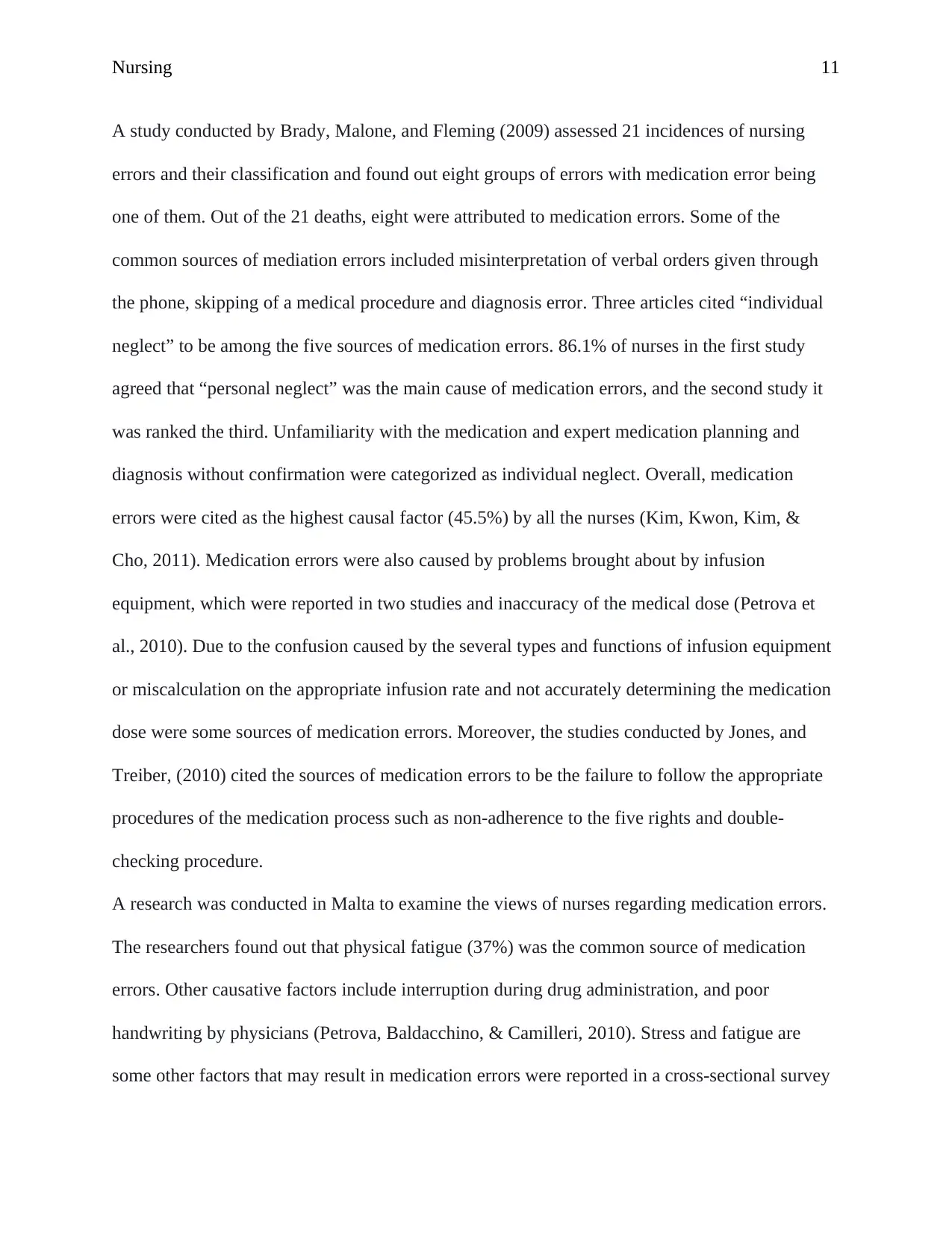
Nursing 11
A study conducted by Brady, Malone, and Fleming (2009) assessed 21 incidences of nursing
errors and their classification and found out eight groups of errors with medication error being
one of them. Out of the 21 deaths, eight were attributed to medication errors. Some of the
common sources of mediation errors included misinterpretation of verbal orders given through
the phone, skipping of a medical procedure and diagnosis error. Three articles cited “individual
neglect” to be among the five sources of medication errors. 86.1% of nurses in the first study
agreed that “personal neglect” was the main cause of medication errors, and the second study it
was ranked the third. Unfamiliarity with the medication and expert medication planning and
diagnosis without confirmation were categorized as individual neglect. Overall, medication
errors were cited as the highest causal factor (45.5%) by all the nurses (Kim, Kwon, Kim, &
Cho, 2011). Medication errors were also caused by problems brought about by infusion
equipment, which were reported in two studies and inaccuracy of the medical dose (Petrova et
al., 2010). Due to the confusion caused by the several types and functions of infusion equipment
or miscalculation on the appropriate infusion rate and not accurately determining the medication
dose were some sources of medication errors. Moreover, the studies conducted by Jones, and
Treiber, (2010) cited the sources of medication errors to be the failure to follow the appropriate
procedures of the medication process such as non-adherence to the five rights and double-
checking procedure.
A research was conducted in Malta to examine the views of nurses regarding medication errors.
The researchers found out that physical fatigue (37%) was the common source of medication
errors. Other causative factors include interruption during drug administration, and poor
handwriting by physicians (Petrova, Baldacchino, & Camilleri, 2010). Stress and fatigue are
some other factors that may result in medication errors were reported in a cross-sectional survey
A study conducted by Brady, Malone, and Fleming (2009) assessed 21 incidences of nursing
errors and their classification and found out eight groups of errors with medication error being
one of them. Out of the 21 deaths, eight were attributed to medication errors. Some of the
common sources of mediation errors included misinterpretation of verbal orders given through
the phone, skipping of a medical procedure and diagnosis error. Three articles cited “individual
neglect” to be among the five sources of medication errors. 86.1% of nurses in the first study
agreed that “personal neglect” was the main cause of medication errors, and the second study it
was ranked the third. Unfamiliarity with the medication and expert medication planning and
diagnosis without confirmation were categorized as individual neglect. Overall, medication
errors were cited as the highest causal factor (45.5%) by all the nurses (Kim, Kwon, Kim, &
Cho, 2011). Medication errors were also caused by problems brought about by infusion
equipment, which were reported in two studies and inaccuracy of the medical dose (Petrova et
al., 2010). Due to the confusion caused by the several types and functions of infusion equipment
or miscalculation on the appropriate infusion rate and not accurately determining the medication
dose were some sources of medication errors. Moreover, the studies conducted by Jones, and
Treiber, (2010) cited the sources of medication errors to be the failure to follow the appropriate
procedures of the medication process such as non-adherence to the five rights and double-
checking procedure.
A research was conducted in Malta to examine the views of nurses regarding medication errors.
The researchers found out that physical fatigue (37%) was the common source of medication
errors. Other causative factors include interruption during drug administration, and poor
handwriting by physicians (Petrova, Baldacchino, & Camilleri, 2010). Stress and fatigue are
some other factors that may result in medication errors were reported in a cross-sectional survey
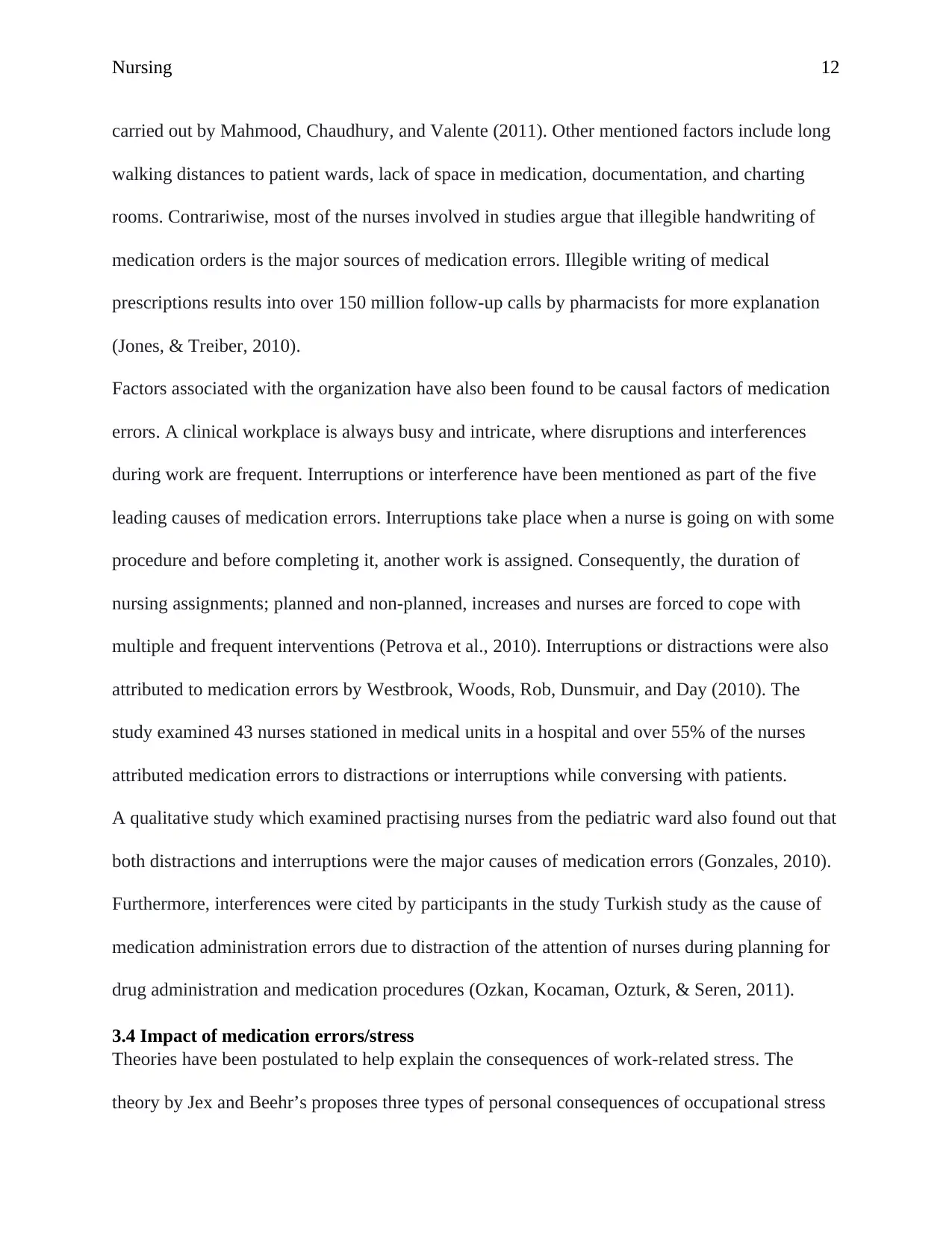
Nursing 12
carried out by Mahmood, Chaudhury, and Valente (2011). Other mentioned factors include long
walking distances to patient wards, lack of space in medication, documentation, and charting
rooms. Contrariwise, most of the nurses involved in studies argue that illegible handwriting of
medication orders is the major sources of medication errors. Illegible writing of medical
prescriptions results into over 150 million follow-up calls by pharmacists for more explanation
(Jones, & Treiber, 2010).
Factors associated with the organization have also been found to be causal factors of medication
errors. A clinical workplace is always busy and intricate, where disruptions and interferences
during work are frequent. Interruptions or interference have been mentioned as part of the five
leading causes of medication errors. Interruptions take place when a nurse is going on with some
procedure and before completing it, another work is assigned. Consequently, the duration of
nursing assignments; planned and non-planned, increases and nurses are forced to cope with
multiple and frequent interventions (Petrova et al., 2010). Interruptions or distractions were also
attributed to medication errors by Westbrook, Woods, Rob, Dunsmuir, and Day (2010). The
study examined 43 nurses stationed in medical units in a hospital and over 55% of the nurses
attributed medication errors to distractions or interruptions while conversing with patients.
A qualitative study which examined practising nurses from the pediatric ward also found out that
both distractions and interruptions were the major causes of medication errors (Gonzales, 2010).
Furthermore, interferences were cited by participants in the study Turkish study as the cause of
medication administration errors due to distraction of the attention of nurses during planning for
drug administration and medication procedures (Ozkan, Kocaman, Ozturk, & Seren, 2011).
3.4 Impact of medication errors/stress
Theories have been postulated to help explain the consequences of work-related stress. The
theory by Jex and Beehr’s proposes three types of personal consequences of occupational stress
carried out by Mahmood, Chaudhury, and Valente (2011). Other mentioned factors include long
walking distances to patient wards, lack of space in medication, documentation, and charting
rooms. Contrariwise, most of the nurses involved in studies argue that illegible handwriting of
medication orders is the major sources of medication errors. Illegible writing of medical
prescriptions results into over 150 million follow-up calls by pharmacists for more explanation
(Jones, & Treiber, 2010).
Factors associated with the organization have also been found to be causal factors of medication
errors. A clinical workplace is always busy and intricate, where disruptions and interferences
during work are frequent. Interruptions or interference have been mentioned as part of the five
leading causes of medication errors. Interruptions take place when a nurse is going on with some
procedure and before completing it, another work is assigned. Consequently, the duration of
nursing assignments; planned and non-planned, increases and nurses are forced to cope with
multiple and frequent interventions (Petrova et al., 2010). Interruptions or distractions were also
attributed to medication errors by Westbrook, Woods, Rob, Dunsmuir, and Day (2010). The
study examined 43 nurses stationed in medical units in a hospital and over 55% of the nurses
attributed medication errors to distractions or interruptions while conversing with patients.
A qualitative study which examined practising nurses from the pediatric ward also found out that
both distractions and interruptions were the major causes of medication errors (Gonzales, 2010).
Furthermore, interferences were cited by participants in the study Turkish study as the cause of
medication administration errors due to distraction of the attention of nurses during planning for
drug administration and medication procedures (Ozkan, Kocaman, Ozturk, & Seren, 2011).
3.4 Impact of medication errors/stress
Theories have been postulated to help explain the consequences of work-related stress. The
theory by Jex and Beehr’s proposes three types of personal consequences of occupational stress
⊘ This is a preview!⊘
Do you want full access?
Subscribe today to unlock all pages.

Trusted by 1+ million students worldwide
1 out of 20
Related Documents
Your All-in-One AI-Powered Toolkit for Academic Success.
+13062052269
info@desklib.com
Available 24*7 on WhatsApp / Email
![[object Object]](/_next/static/media/star-bottom.7253800d.svg)
Unlock your academic potential
Copyright © 2020–2025 A2Z Services. All Rights Reserved. Developed and managed by ZUCOL.




